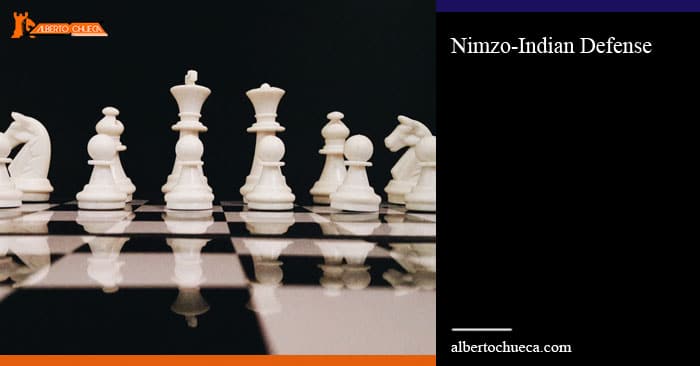Table of Contents
Nimzo-Indian Defense
Are you having some trouble when facing Queen’s Pawn? Would you like to learn and play some interesting and annoying variation against it? In this post, we are going to analyze a very strong system: Nimzo-Indian Defense (named after the great Aaron Nimzowitsch).
This is one of the best lines Black can play against Queen’s Pawn, the second player is getting a balanced game in almost the lines, and it is really hard for White to get anything from the opening in these variations. It is strongly recommended for all levels, from beginners to masters, and it has been said that all World Champions since Capablanca have used it in their games.
We have Nimzo-Indian after the moves
1.d4 Nf6 2.c4 e6 3.Nc3 Bb4
Black develops very quickly the Knight and Bishop from the kingside, so they will be able to castle very soon. In the beginning, they did not fight for the center with pawns, but in the next moves and the middlegame, they will, as it usually happens in Indian defenses.
One of the basic ideas in this defense is to capture the Knight on c3, creating some weakness in White’s structure because of the doubled pawns on the “c” file (of course, White can always get some compensation with the two bishops).
This plan is so annoying (and Nimzo-Indian is so strong), that very often White is going to avoid it, by playing 3.Nf3, so Bb4+ (Bogo-Indian Defense) is not creating any real problem now. After 3.Nf3, the most popular line will be 3. … b6 (Queen’s Indian Defense), which is another strong and famous variation. We are not studying that in this post, although probably in some next one we will.
Some theory and ideas: Rubinstein and Classical
1.d4 Nf6 2.c4 e6 3.Nc3 Bb4
At this point White has two main options to reply:
- Rubinstein Variation
4.e3
This is a normal development move, protecting the central pawn on d4 and also clearing the line to develop the Bishop (and maybe the Knight).
- … 0-0 5.Bd3 d5
Finally Black starts fighting against White’s central pawns.
6.Nf3
This Knight can also be developed over e2 in Rubinstein Variation. In general, that does not change too much Black’s plan.
- … c5 7.0-0 Nc6 =
There is a lot of tension in the center and both sides have one undeveloped piece. The game is balanced.
- Classical Variation (Also known as Capablanca Variation)
4.Qc2
The idea of this move is to protect the Knight, so, if Black captures on c3 at some point, White can retake with the Queen and avoid any damage in the pawn structure. The drawback is that this move Qc2 is not really developing.
- … 0-0
Other interesting and strong moves here are d5 and c5.
5.a3 Bxc3 6.Qxc3 b6 7.Bg5 Bb7 =
Black does not have any problem here. They even have a nice development advantage. Also, they are ready to fight for the center with the typical moves c5 and d5.
Some theory and ideas: Kasparov, Leningrad, and Samisch
White can also play other moves at his turn number 4 (like 4.Nf3 Kasparov, 4.Bg5 Leningrad, or 4.a3 Samisch Variations). We could say these are not as strong as Rubinstein or Classical, but even though, we can take a brief look at the theory:
- Kasparov Variation
4.Nf3 c5 5.g3 cxd4 6.Nxd4 0-0 =
- Leningrad Variation
4.Bg5 h6 Bh4 c5 =
- Samisch Variation
4.a3 Bxc3 5.bxc3 c5 6.e3 0-0 =
(See the Typical Pawn Structures section)
Typical Pawn Structures
White: a2, c3, c4, d4, e4, f2, g2, h2
Black: a7, b6, c5, d6, e5, f7, g7, h7
This is the most classical and typical pawn structure we could see in Nimzo-Indian. It is also an important strategical structure to learn and understand how to fight and exploit doubled pawns. The pawn on c4 is not protected by other pawns, so it is a weakness, and in these positions, Black is going to attack this pawn very strongly with pieces.
At some moment, White should play d5, so they will have some space advantage in the center and the kingside, and they could try some actions over there.
Typical Middlegame Plans for Black
If finally, Black can get the typical pawn structure we just analyzed, the plan is to target c4, with moves like Na5, Ba6, and Qa4. If White did not play d5 then the Rook can also come to c8 and threaten cxd4, clearing the file and then attacking c4 with one more piece.
Besides Black can try d5 and after the central exchange and trading the light squares Bishops, they could use c4 as a nice outpost. In this plan, White is getting rid of the weak pawn, but the outpost for Black on c4 will be a new problem.
If White avoided this pawn structure, then the plan will depend on the position, but very often Black has to attack white center with moves like c5 or d5.
Typical squares for black pieces
King: We could say Black always castles kingside
Queen: When we have the pawn structure with doubled “c” pawns, very often the Queen goes to a4 via d7 and performs a significant pressure on c4.
Rooks: c8 and d8 squares are very well in doubled “c” pawns structures. In other lines, the central files should be also fine, as there is tension in the center and some of those files could eventually be open.
Bishops: Dark squares Bishop is very often traded on c3 to create doubled pawns. Light squares Bishop could go to the Great Diagonal over the Fianchetto, notice that in Nimzo-Indian Black plays 2. … e6, so, rarely that Bishop can be developed over the diagonal c8-h3. Also, a6 is an important development possibility, because from that square the Bishop will attack c4.
Knights: The Knight from the kingside will try to get the nice square e4 in several variations. The Knight from the queenside can go c6-a5 when there are doubled pawns. In other structures, it can just go to c6 and perform an annoying central pressure on d4.









2 Responses
Ninguna de las variantes mencionadas en su artículo me lleva a la estructura de peones más clásica y típica que menciona en su artículo ¿porque es esto?
Hay muchas transposiciones y depende mucho de cuando el blanco introduce a3 ya que el negro captura en c3. Hay mediojuegos donde el blanco empieza con e3 pero luego finalmente acaba haciendo e4 mucho más adelante. Depende de cuando el blanco haga a3 ya que puede ser en la jugada 4, 10 o 15 :)